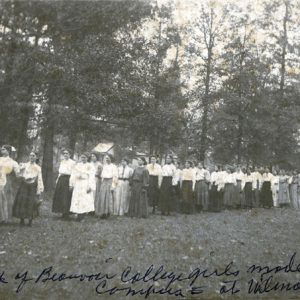calsfoundation@cals.org
Beauvoir College
In 1897, John Jefferson Lee Spence established the Drew Normal Institute in the town of Wilmar (Drew County). On May 27, 1903, the school was “chartered with the privilege of conferring degrees” by the Arkansas Board of Education. Subsequently, the college was renamed Beauvoir College, after the Mississippi estate where Jefferson Davis, the former president of the Confederacy, retired. The college was initially a success, but Spence, founder and the institution’s only president, was forced to close the college in 1907. Despite the brevity of its existence, Beauvoir College signaled a new trend in higher education, as the institution sought to meet the higher-educational needs of southeast Arkansas’s working-class and rural population.
Educated at the University of Mississippi, Spence came to Monticello (Drew County) in 1892 and became a member of the local Associate Reformed Presbyterian congregation. Originally, his goal was to work in public education for a few years, and then pursue a career in medicine. Recognizing a dearth of higher-educational opportunities in the region, he retooled his career ambition and let it be known that he intended to establish a school. Subsequently, the town of Wilmar offered Spence an ideal opportunity to pursue his endeavor.
This opportunity arose when prominent Wilmar residents Judge I. A. Bird and Major J. T. D. Anderson donated property for the school. Capitalizing on the town’s successful timber industry, the town offered to bear half the cost of the school’s construction. Finally, Colonel A. H. Gates provided a 300,000-gallon-capacity artesian well for the college. Over the next ten years, the college served scores of students across the region.
Described as “The Pioneer Boarding School in Southeast Arkansas for Whites,” Beauvoir College was independent and coeducational, “affording higher educational advantages to the youth of Southeast Arkansas.” At its apex, the college’s enrollment reached 469 in 1906–07. Students were permitted to pay their tuition in cash, crops, or livestock. In some instances, students were offered employment on campus. If a student was unable to pay the tuition, the student could pay the bills after graduation, when he or she was employed. The college even provided job placement assistance.
Beauvoir College also served as a dynamic center of culture in the region. The campus was adorned with elegant wooden structures and a prominent parade ground. A 500-seat auditorium hosted several musical productions and renowned guest speakers. In 1906, the famed orator William Jennings Bryan came to the campus to speak to an enthusiastic audience whose members had traveled to Wilmar from across the region.
Teacher training was critical to the college’s academic mission. Beauvoir’s music and elocution departments, however, were the crown jewels of the institution. Each department featured instructors whose advanced and international training provided the college with a unique level of academic prestige.
By 1905, the fortunes of the college began to change. In that year, a smallpox epidemic claimed forty lives in Wilmar, including those of one Beauvoir student and Spence’s five-year-old son. Then, in 1907, a national economic crisis, the “Panic of 1907,” devastated the local economy and forced the college to close. Spence disassembled half of the college’s structures and moved them to Monticello. Only foundation lines remain in Wilmar today.
In 1909, the Arkansas state legislature passed Act 100, creating state-sponsored agricultural schools in each of the state’s four geographical quadrants. These state-sponsored schools were created, by and large, to meet the higher-educational needs that Beauvoir College sought to address. Spence continued working in higher education, first as president of Hinemon University in Monticello, and then at the Fourth District State Agricultural School, later known as University of Arkansas at Monticello.
For additional information:
Beauvoir College: Ninth Annual Catalogue and Announcements of Beauvoir College, 1906–7. Monticello, AR: 1906. On file at Taylor Library Special Collections. University of Arkansas at Monticello, Monticello, Arkansas.
Beauvoir College: Seventh Annual Catalogue And Announcements of Beauvoir College. 1904-5. Pine Bluff, AR: Adams Printing Co., 1904. On file at Taylor Library Special Collections. University of Arkansas at Monticello, Monticello, Arkansas.
Coleman, Tom C. “A School Tale.” Drew County Historical Journal 4.1 (1989): 71–81.
DeArmond, Rebecca. Old Times Not Forgotten: A History of Drew County. Little Rock: Rose Publishing Co., 1980.
Reaves, Wanda Beaty. Wilmar, Arkansas: Scrapbook of Memories. N.p.: 2005.
Spence, William Tyler.” History of Beauvoir College.” Arkansas Historical Quarterly 17 (Winter 1958): 325–336.
Stewart, Kate. “Beauvoir: The Erskine of the West.” The ARP: The Associated Reformed Presbyterian, February 1992, 8–10.
———. “Little Benjamin Goes West: Associate Reformed Presbyterians in Drew County.” Drew County Historical Journal 5.1 (1990): 6–17.
Paul Edwards
Boston, Massachusetts
 Beauvoir College Students
Beauvoir College Students 



Comments
No comments on this entry yet.